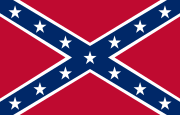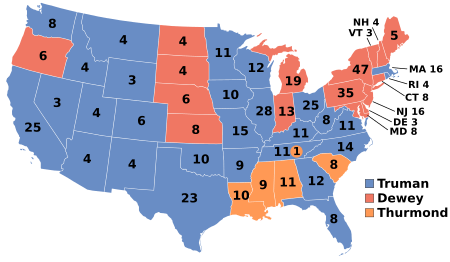Dixiecrat facts for kids
Quick facts for kids
States' Rights Democratic Party (Dixiecrats)
|
|
|---|---|
| Founded | 1948 |
| Dissolved | 1948 |
| Split from | Democratic Party |
| Ideology | |
| Party flag | |
 |
|
The States' Rights Democratic Party, often called the Dixiecrats, was a political party in the United States that didn't last very long. It was mainly active in the South. This party formed because many Southern politicians disagreed with the main Democratic Party.
In 1948, President Harry S. Truman, a Democrat, ordered the integration of the military. He also took other steps to support African Americans' civil rights. Many white Southern politicians were against these changes. They decided to form their own group, the Dixiecrats. Their main goal was to protect the Southern states' "states' rights" to keep racial segregation.
Supporters of the Dixiecrats took control of the Democratic Party in some Southern states. The party was against racial integration and wanted to keep Jim Crow laws and white supremacy. The name "Dixiecrat" is a mix of "Dixie" (a nickname for the South) and "Democrat."
Even though the Dixiecrats were strong in some states, Truman still won the election. After the 1948 election, most Dixiecrat leaders went back to the Democratic Party. Their presidential candidate, Strom Thurmond, later became a Republican in 1964. The Dixiecrats showed that the "Solid South" was starting to weaken. The "Solid South" meant that Southern Democrats usually won presidential elections and most Congress seats in the South. This was partly because they had prevented many black people from voting for decades.
Contents
Why the Dixiecrats Formed


For a long time after the Civil War, white voters in the South strongly supported the Democratic Party. This was known as the "Solid South". Democrats used violence and unfair tactics to stop Republican voters, especially formerly enslaved black people. They took control of state governments and passed new laws between 1890 and 1908. These laws stopped most black people and many poor white people from voting.
They also created Jim Crow laws. These were legal and informal rules that kept black people separate and treated them as second-class citizens. This system was the foundation of society and the economy in the Solid South.
In the 1930s, President Franklin D. Roosevelt introduced his "New Deal" policies. These policies changed the Democratic Party. Many Southern Democrats supported the economic changes. However, civil rights for African Americans were not a big part of the New Deal. This was partly because Southern politicians held many powerful positions in Congress.
During World War II, things started to change for Jim Crow laws. Over 1.5 million black Americans served in the military. They received equal pay, even though they were in separate units. They also got veterans' benefits after the war. Many black civilians also found jobs in war industries. This was due to a rule that said defense industries could not discriminate based on race.
Many Republicans and Democrats from the North and West supported civil rights laws. But Democrats from the Deep South in Congress almost always opposed them. Some historians and journalists have said that the Dixiecrats were connected to groups like the Ku Klux Klan. They were a far-right group that opposed President Truman, integration, and modern ideas about fairness.
The 1948 Presidential Election
After President Roosevelt died, Harry S. Truman became president. In 1948, Truman created a committee to study civil rights. He also issued an order to end racial discrimination in the military. This made many Southern governors angry.
Southern governors, including Strom Thurmond of South Carolina, met to discuss their place in the Democratic Party. They decided to hold their own convention if Truman and his civil rights supporters won at the main Democratic convention. In July, the Democratic Party nominated Truman for president. They also adopted a strong civil rights plan. Because of this, 35 Southern delegates walked out of the convention. They wanted to remove Truman's name from the ballot in the South. This led to the creation of the States' Rights Democratic Party.
Just a few days later, the States' Rights Democrats held their own convention in Birmingham, Alabama. Many important Southern Democrats did not attend. They nominated Strom Thurmond for president and Fielding L. Wright as his running mate. Thurmond was chosen because he was well-known.

The States' Rights Democrats did not say they were a new party. Instead, they said they were "recommending" that state Democratic Parties vote for Thurmond and Wright. Their goal was to win the 127 electoral votes from the Solid South. They hoped this would stop Truman or the Republican candidate, Thomas E. Dewey, from getting enough electoral votes to win. If no one won, the election would go to the United States House of Representatives. The Dixiecrats hoped to support whichever party would agree to their demands for segregation.
The States' Rights Democrats managed to make the Thurmond–Wright ticket the official Democratic ticket in Alabama, Louisiana, Mississippi, and South Carolina. In other states, they had to run as a separate third party.
At their second convention in Oklahoma City, the Dixiecrats shared their party platform. It said:
We stand for the segregation of the races and the racial integrity of each race; the constitutional right to choose one's associates; to accept private employment without governmental interference, and to earn one's living in any lawful way. We oppose the elimination of segregation, the repeal of miscegenation statutes, the control of private employment by Federal bureaucrats called for by the misnamed civil rights program. We favor home-rule, local self-government and a minimum interference with individual rights.
They also called for all Democrats and Americans to unite and defeat Harry S. Truman, Thomas E. Dewey, and any other candidate who would create a "Police Nation."
On election day in 1948, the Thurmond–Wright ticket won Alabama, Louisiana, Mississippi, and South Carolina. They received over 1.1 million popular votes and 39 electoral votes. Many people expected the Republican candidate, Dewey, to win because the Democratic Party was split. However, Truman surprised everyone and won the election.
What Happened Next
The States' Rights Democratic Party broke up after the 1948 election. Truman and the Democratic Party worked to make sure the Dixiecrat movement would not return in the 1952 election. Some former Dixiecrats faced challenges at the 1952 Democratic National Convention. But all Southern groups were allowed to participate after they promised loyalty to the party. A moderate senator from Alabama, John Sparkman, was chosen as the Democratic vice presidential candidate in 1952. This helped to keep the South loyal to the party.
Even though there were disagreements about segregation, the South remained strongly Democratic for local and Congressional elections. However, this started to change for presidential elections. Republican Dwight D. Eisenhower won several Southern states in the 1952 and 1956 elections. In the 1964 election, Republican Barry Goldwater won all four states that Thurmond had carried in 1948. By the 1968 election, Republican Richard Nixon or third-party candidate George Wallace won almost every former Confederate state.
Presidential Election Results
| Year | Presidential candidate | Vice President | Popular votes | Percentage | Electoral votes |
|---|---|---|---|---|---|
| 1948 |  Strom Thurmond |
 Fielding L. Wright |
1,175,930 | 2.4% | 39 |
Images for kids
See also
 In Spanish: Dixiecrat para niños
In Spanish: Dixiecrat para niños




